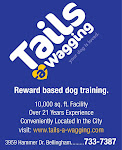A dear client of our shared the following with us. We were so moved by it, we wanted
to share it with you. Enjoy!
Hi Angi,
I wanted to share with you my husband's speech to his
school district staff because it has to do with Kona. He is the superintendent of the Meridian school
district and this is an excerpt of his "kick-off the year" speech to
all district staff. He projected a picture of Kona on the gym wall as he began
his speech.
Needless to say it has been a busy summer living
with a puppy in our house. The cat is really mad.
KONA is always happy, always eager and always
excited. 24 hours a day. She is a non-‐stop bundle of energy, is easily
distracted by shiny things, sticks, leaves, things that smell good or things
that smell bad, things that move, things that don’t move, dead things and more.
She easily loses focus.
What I have learned this summer is that just
“wanting” her to “be a good puppy” is not enough. It’s become clear that I need
to have a better strategy than “wishing and hoping.”
I first learned this when KONA struggled in the
first class at puppy preschool and we were encouraged to get “private” training
for her. Of course, I immediately thought, “Yeah. Somebody should teach that
dog to behave.” Of course, I found out was that the training is not for the
dog, but for the humans (my wife Patty and I) so we could learn how to teach
her to “be a good puppy.”
Here are 8 things we learned. You, as educators,
may recognize some of these, as we did.
1. We learned
that being intentional is more effective than being reactive. Telling her what we wanted her to do rather
than telling her what not to do is better in the long run.
2. We learned
that she needs to understand what we want her to do if we expect her to do it.
3. We learned
that we needed to break down what we wanted her to learn into small steps.
4. We learned
that we could not just teach her one time, but that we had to reteach,
sometimes many times, before she found success.
5. We learned
that positive reinforcement is effective and works better than punishment.
6. We learned
to look and plan ahead to structure her environment so that she will be
successful and to try not to put her in situations where she will not.
7. We learned
that it is unrealistic to expect things to be perfect right away and that there
will some mistakes made along the way.
8. We learned
to look for growth over time and to celebrate successes along the way. We haven’t
made any color-coded graphs yet or assembled a data team but we have seen
measurable growth.
The message
is, of course, that puppies like children don’t just learn everything on their
own without guidance and support. What the adults in their lives do to guide
them is what really matters. Teaching matters. Teaching well matters.
Thank you
for your professional work. What you do
as the adults does make a difference for kids…..and puppies. Have a great year!





